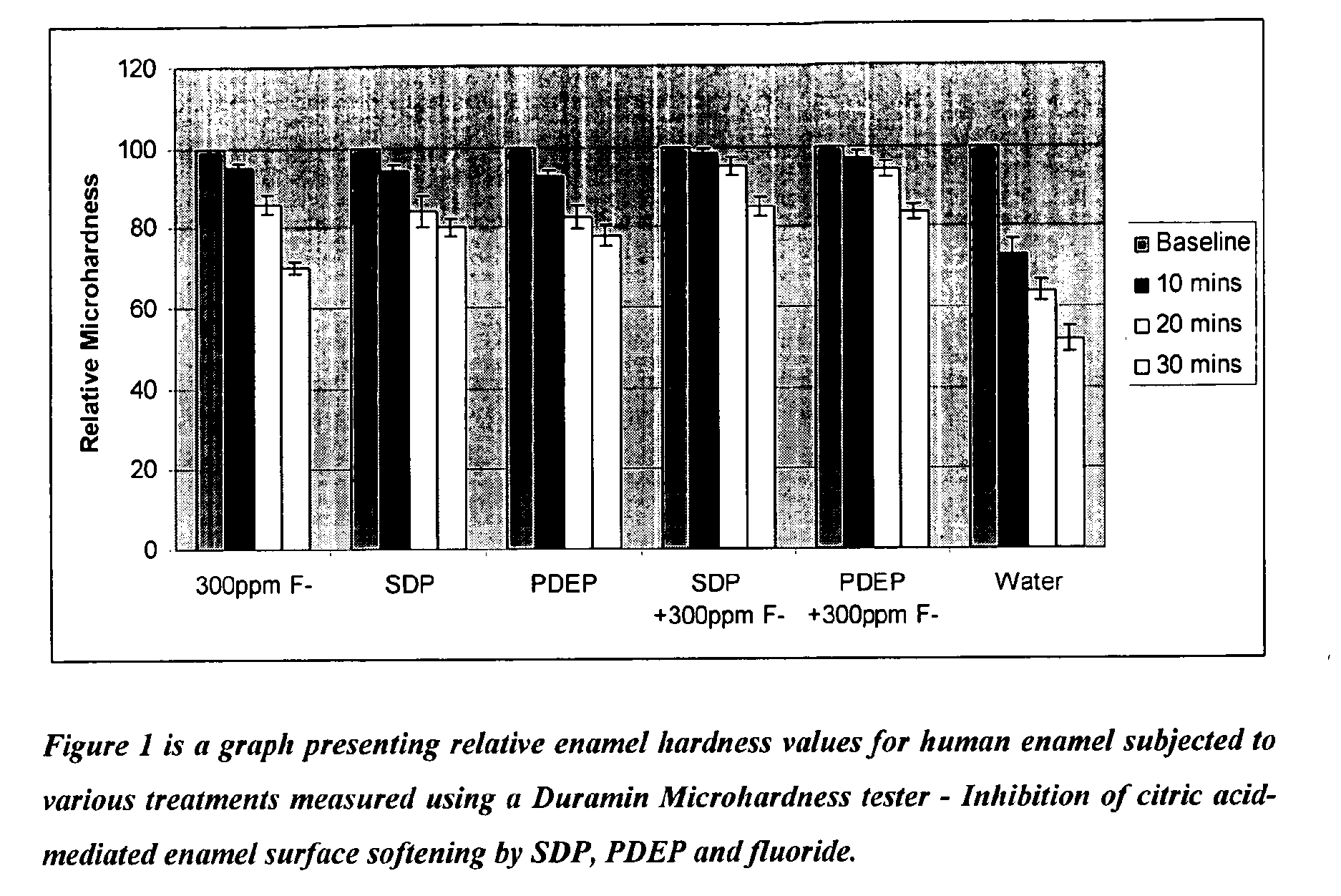Novel use of alkyl phosphate esters
a technology of alkyl phosphate and esters, which is applied in the field of oral care compositions, can solve the problems of mutans /i>may become pathogenic, acidogenic bacteria, and progressive tissue loss and eventually cavity formation
- Summary
- Abstract
- Description
- Claims
- Application Information
AI Technical Summary
Problems solved by technology
Method used
Image
Examples
example 1
Inhibition of Citric Acid-Mediated Enamel Surface Softening Using SDP and PDEP
[0038]The first stage of dental erosion and acid wear involves demineralisation of the hard tissue surface and consequent surface softening. The present study employed a Duramin Microhardness Tester to assess the protective effect of SDP and PDEP against an erosive challenge based on citric acid. A Vickers indentor was employed, and a load of 1.961N applied for 20 seconds.
[0039]Sound human enamel specimens were polished with 2400 grit abrasive and subsequently immersed in an aqueous solution of the specified treatment at pH 7 for 2 minutes under ambient conditions, with agitation. After rinsing with deionised water, the enamel specimens were exposed to an erosive challenge comprising an aqueous solution of 0.30% w / w citric acid monohydrate, pH 3.6. The extent of acid damage was assessed by monitoring the decrease in enamel surface hardness as a function of acid exposure time. The microhardness value for ea...
example 2
Inhibition of Citric Acid-Mediated Enamel Surface Softening by Tryfac 5559 and Crafol AP261
[0041]The microindentation protocol described in Example 1 was used to evaluate a number of alkyl polyoxyethylene phosphates including Tryfac 5559 and Crafol AP261. The actives were tested as aqueous solutions at 0.50% w / w and pH 7. The results of this study are shown in FIG. 2 and Table 2. These show that Tryfac 5559, Crafol AP261 and the fluoride positive control give similar and statistically significant inhibition of surface softening at the 20 and 30 minute time points relative to the water control. Of the two alkyl phosphates, Tryfac 5559 appeared to give somewhat greater protection against the citric acid challenge. When Tryfac 5559 was tested in combination with 300 ppm fluoride, no statistically significant improvements were seen compared to the single active treatments, however the combination treatment was directionally superior at 30 minutes.
TABLE 2300 ppmTryfac +FluorideTryfac300...
example 3
Enamel Solubility Reduction by Alkyl Phosphates Using Citric Acid
[0042]FDA caries monograph enamel solubility reduction (ESR) model #33 is designed to evaluate in vitro the utility of fluoride toothpastes to protect enamel against a bacterial (lactic) acid challenge. In brief, enamel specimens are placed in a lactic acid challenge (pH 4.5) and the solubility determined by spectrophotometric analysis of released phosphate. Specimens are then placed in the relevant treatment solution derived from the supernatant of a 1:3 slurry of the toothpaste in deionised water. After 5 minutes the specimens are removed, rinsed, and placed in a fresh lactic acid challenge. The enamel solubility is determined once again, and the ESR value calculated as a percentage reduction relative to the baseline solubility.
[0043]The methodology described above was modified in order to evaluate the ability of putative anti-erosion actives to confer protection against a more aggressive dietary acid challenge. In t...
PUM
| Property | Measurement | Unit |
|---|---|---|
| Fraction | aaaaa | aaaaa |
| Fraction | aaaaa | aaaaa |
| Fraction | aaaaa | aaaaa |
Abstract
Description
Claims
Application Information
 Login to View More
Login to View More - R&D
- Intellectual Property
- Life Sciences
- Materials
- Tech Scout
- Unparalleled Data Quality
- Higher Quality Content
- 60% Fewer Hallucinations
Browse by: Latest US Patents, China's latest patents, Technical Efficacy Thesaurus, Application Domain, Technology Topic, Popular Technical Reports.
© 2025 PatSnap. All rights reserved.Legal|Privacy policy|Modern Slavery Act Transparency Statement|Sitemap|About US| Contact US: help@patsnap.com



